The iconic “Meditation Posture” seen in many publications is often misleading as a guide to real-life sitting for meditation. In advertising photographs the head is thrown back with neck jutting forward. The spine is sometimes shown as rigid. This position is neither healthy, nor sustainable. Sitting this way might be appropriate for a briefly-held Yoga pose, but should not represent the right posture for meditation. It takes so much effort to hold this pose that it won’t last much longer than the time it takes to click the shutter. This popularized image of what meditation is supposed to look like is conceived by those who have neither practiced meditation nor plan to.
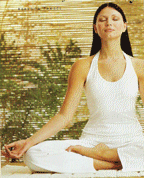
Typical deceptive advertising showing sitting flat on floor. It is impossible to hold this pose for long unless you have grown up sitting this way.
Models are often shown sitting directly on the floor, though sitting in meditation on a flat surface is almost worse than sitting on a chair for work or a sofa. The musculature of the front torso has to strain to keep the body from collapsing backward. For meditation, we need to strive to sit as effortlessly as possible in order to increase the power of concentration, lower heart rate, decrease blood pressure, deepen breathing, and stimulate the ‘relaxation response.’
“Good posture” is not the military tightening of the shoulders with an erect back. In fact, ‘posture’ isn’t even the word to describe the activity of meditation. (Note that the Lotus Pose in Yoga is used for meditation by advanced Yoga practitioners. It can be done on a flat surface because the true Lotus tilts the pelvis mechanically by extreme force when the legs are stretched under the calves and the feet rest on top of the thighs. There are relatively few people who can achieve the true lotus without injury and even fewer who can maintain the pose comfortably for the purpose of meditation.)
Meditation is an activity rather than a static ‘holding’ of the body. In fact, holding the body creates a sensation of having ‘body armor,’ which is just what we are trying to dissolve with meditation. Meditation is a ‘neutral’ state.’ It is a state of repose, looseness, relaxation, melting, zero, reset. The goal in sitting is to provide a place for the physical body to ‘let go’ so the mind and spirit, or emotions, can work on whatever they have to, without being hindered or blocked by the body.
-
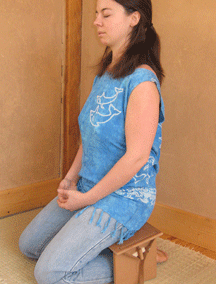
The Kneeling Position (a.k.a. VIJRASASA and SEIZA) on a Peace Bench™
-
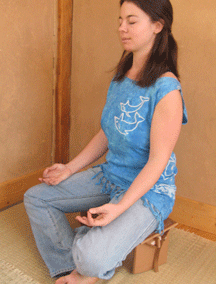
The SKY POSITION on a PEACE BENCH™
-
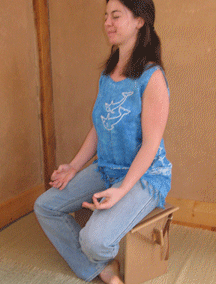
The SKY POSITION on a SKY BENCH™
-
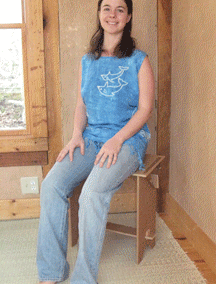
Sitting on Tilt Seat with feet in front.
-
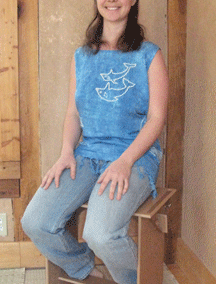
Sitting on Tilt Seat™ with feet in back ankles resting on lower bar.
There is a koan or dichotomy using proper sitting techniques. By settling down the body in this consciously controlled way, the mind is freed from its constant distractedness. It now has to face itself. By stopping the body’s outward movement, the mind is now able to find new levels of awareness, which is a form of movement. The reason “posture” isn’t the best word to describe meditation is because there is very much movement inside the sitting. The body is in a state of “tonus” which means there is an equal balance of work between complimentary and opposing muscle groups. The muscles involved from the front are working with those of the back. There is a constant interchange.
When the weight of the body is balanced evenly front and back, there is very little work left to do, and so the body does not become tired quickly The only way these muscles can be balanced between the front and the back is by either standing, or by mimicking the angle of the spine by sitting on a sloped surface. This sloped surface tilts the pelvis almost as it would be when standing.
There are several obstacles to finding this state of perfect repose.
- Improper technique or knowledge of how the body works.
- The body may be out of alignment.
- Muscles needed for proper sitting have weakened from years of sitting in chairs. Strengthen muscles by starting autonomous sitting in small bits and work your way to longer sits as you can. Practice plenty of stretching in-between sitting.
- Your sitting equipment may not fit you or have some other technical issue.
Here is a very good video demonstrating the ideas in this article.
Read this website, read the books offered on this website, and find qualified instructors of the Feldenkrais Method. Yoga is very complimentary to a healthy back and can enhance meditation. Unfortunately, even yoga instructors usually do not understand the problems with chairs and the principles of wise body movement. They even use unhealthy backrests in the yoga classes for students to lean back on. These canvas floor seats are actually worse than chairs!
Alignment means the bones, joints and muscles are working smoothly together with symmetry and balance. It would be amazing if a person beginning this way of sitting wasn’t out of alignment. Our physical environment and the way we interact with it shapes our bodies. Chair sitting creates a condition known as “adaptive slumped posture” or “front loading”. The muscles in the front (shoulders, chest, abdominals) work harder than those in back, and sculpt a body that tends to pull itself unnaturally forward. This can then lead to problems in other areas of the body, like a domino effect. These problems can become severe and lead to joint degeneration from uneven wear. We have become adapted to chairs. Chairs support the status quo of a “front loaded” body. That’s why at first they may seem more comfortable and relaxing than autonomous sitting. It takes an open mind and a desire for balance, health, and the benefits of meditation for a person to want to change. The transition is not always easy. In order to make it work, other practices should be considered for increasing flexibility, balance and symmetry, such as yoga, chiropractic, rolfing, massage, craniosacral therapy, the Alexander Technique. Also, there are many self-therapies that are very useful, such as the Ma Rollerª, Miracle Ballsª, therapy balls. and others.
The seat must fit. If a seat is too tall, it may cut off circulation where the seat meets the thighs. If it’s too short, the pelvis isn’t tilted sufficiently and there will be slumping. In general, the wider the sitting surface, the easier it will be to sit, because the weight of the body is spread across more surface area to prevent bruising and circulation blocks. If your legs tingle and fall asleep, try another seat.
The principles of comfortable, healthy sitting can be applied to sitting in a chair. If the seat of a chair is tilted somehow, either by placing one inch blocks underneath the rear legs, or by placing a ‘wedge cushion’ (Tilt Seat™ cushion with stuffing pushed to the rear) on the seat, it becomes effective for autonomous sitting.
The floor cushions and benches have a few advantages–lower center of gravity, simple, easy for a large group, humble and ‘down to earth’– but some people have trouble getting up and down or assuming the positions which take greater flexibility. For this group, and others, we have created the Tilt Seat™. Also, somewhere between a Tilt Seat™ and a Zafu or Peace Bench is the “sky position”. The sitter is not as high as a chair or tilt seatª but not as low as a zafu or kneeling bench. The knees are lower than the hips, but still not touching the mat or floor. There is minimal stretch in the thighs and no pressure on the knees. Many have found the answer with this position, which can be achieved with either an extra large bench or a smile cushion or zafu with a support cushion under it.
Click here for illustrated instructions on the different sitting positions.
After checking out the illustrated instruction on different positions click here for Live & Dare’s list of best cushions to try those positions out on. It’s a list of the best cushions, and that’s why Carolina Morning Design’s zafus are on it.
Back, Head, Shoulders
“Wise Use” of the body starts with the head. The head should be positioned “forward and up”. That means the chin should be parallel with the floor, so you can easily look down at a 45 degree angle to the floor. (Many people make the mistake of bending the neck up. This throws the whole back out of alignment.) Correct positioning of the head should help you naturally align you back.
You should feel a slight arch in your lower back. Play with the balance until you find a place that feels comfortable. Do not strain. When done properly this way of sitting is comfortable and effortless. Your ears and your shoulders should be on one vertical line. Relax your shoulders, and push up towards the ceiling with the back of your head. Also to gain strength in your posture, press your diaphragm down towards your hara, or lower abdomen. This will help you maintain physical and mental balance.
Arms & Hands
You can place your hands on your thighs or on a small pillow on your lap. Hold your elbows freely and easily, and slightly away from your body. This helps keep your shoulders from slouching.
